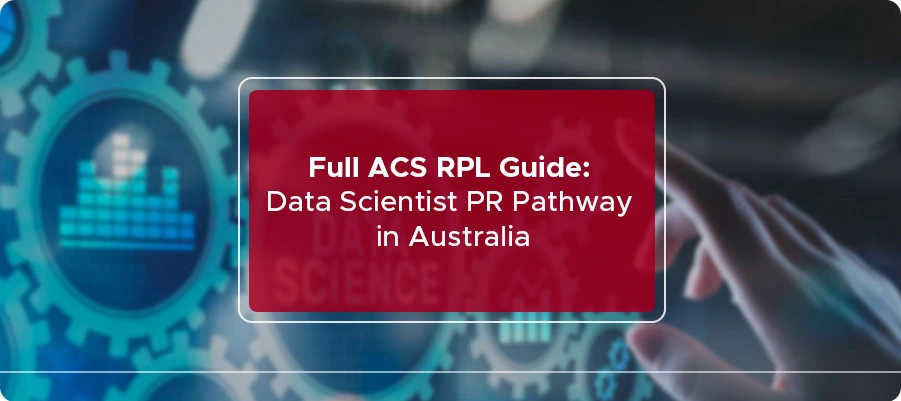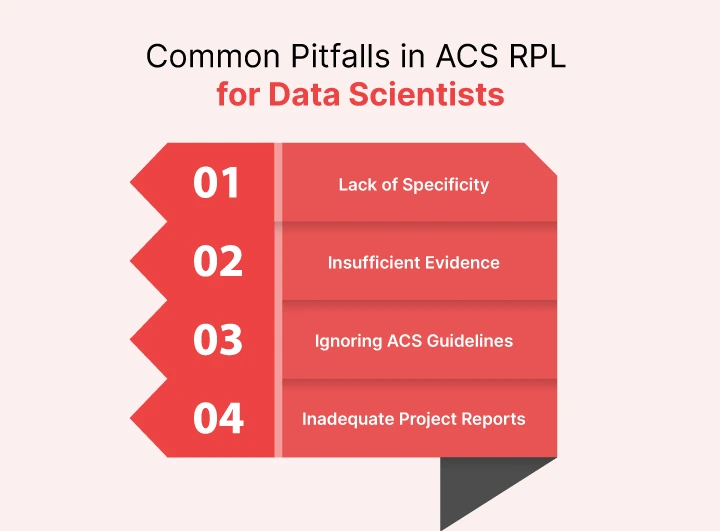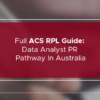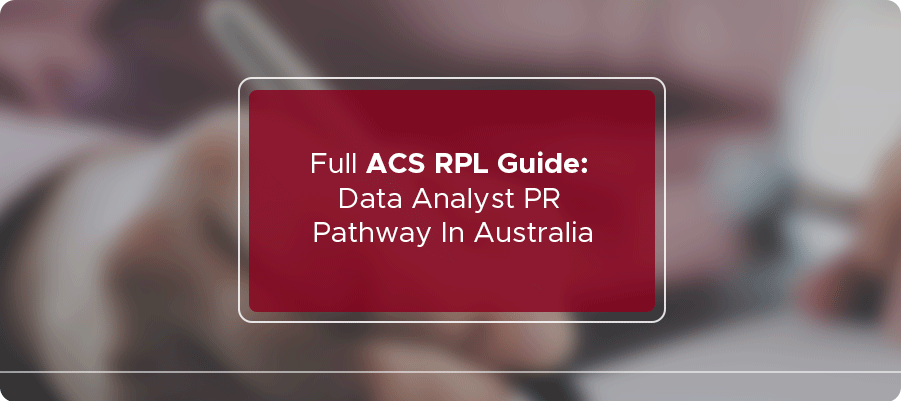
Full ACS RPL Guide: Data Scientist PR Pathway in Australia
Australia has become a sought-after destination for IT professionals, including data scientists, looking to enhance their careers and secure permanent residency (PR).
For those who lack formal qualifications but have substantial industry experience, the Australian Computer Society (ACS) provides a pathway through the Recognition of Prior Learning (RPL) process.
This guide will walk you through everything you need to know about the ACS RPL for Data Scientists, covering each step of the process, tips for a successful submission, and how this can lead to your PR in Australia.
🔑 Key Highlight
- ACS RPL is a pathway for experienced data scientists without formal qualifications to secure PR in Australia.
- ACS RPL provides an opportunity to gain recognition for industry experience, opens doors for employment and visa approval, and serves as a pathway to permanent residency.
- Key components of ACS RPL include the RPL application form, key areas of knowledge, and project reports.
- The ACS RPL Process involves checking eligibility, familiarizing yourself with key areas of knowledge, understanding the RPL form, preparing your application, submitting and evaluating it, and taking the next steps.
What is ACS RPL for Data Scientists?
ACS RPL (Recognition of Prior Learning) for Data Scientists is a specialized pathway that allows IT professionals without an accredited qualification to demonstrate their knowledge and skills through documented experience.
The Australian Computer Society assesses this experience to determine if it meets the standards required for a skilled migration visa.
A data scientist develops machine learning models and has skills in data mining, data analytics, data visualization, and reporting, plus skills relating to database technologies, programming, and advanced analytics such as predictive and prescriptive analytics as well as other artificial intelligence techniques.
Why is the ACS RPL Important for Data Scientists?
The ACS RPL for Data Scientists is vital because it opens doors for professionals who may not have traditional degrees but possess significant experience in the industry. For many, this pathway is the only option to achieve PR in Australia.
As data scientists become increasingly essential in various sectors, the demand for skilled data scientists continues to rise. However, it can be challenging to secure employment and visa approval in Australia without the proper recognition of your skills.
The ACS RPL enables you to:
-
Demonstrate your expertise
Show that your experience and skills match the Australian standards for data scientists.
-
Secure employment
Gain the recognition needed to be considered for roles in Australia.
-
Pathway to PR
Fulfill one of the essential requirements for skilled migration visas.
Key Components of the ACS RPL Application

1. RPL Application Form
The RPL application form is the foundation of your submission. It requires detailed information about your educational background, work experience, and the skills you have developed throughout your career. The form includes two key sections:
- Key Areas of Knowledge
This section requires you to map your experience to the specific areas of knowledge defined by the ACS. You must select and provide evidence for at least two of the six Key Areas of Knowledge.
- Project Reports
You need to submit two project reports, each demonstrating your application of ICT skills in real-world scenarios. These reports should showcase your ability to solve complex problems, manage projects, and apply data science techniques.
2. Key Areas of Knowledge
The ACS has identified six Key areas of knowledge that are essential for ICT professionals. For data scientists, the most relevant Key Areas of Knowledge are:
- Data Management and Analytics
This area focuses on your ability to manage, analyze, and interpret data to inform decision-making processes. It includes knowledge of data mining, statistical analysis, and machine learning.
- Programming and Software Development
Demonstrating your proficiency in programming languages such as Python, R, or SQL and your ability to develop software solutions.
- ICT Management and Governance
This area relates to your understanding of the broader ICT environment, including project management, governance frameworks, and the ethical implications of data science.
3. Project Reports
The project reports are the most critical component of your RPL application. Each report should be between 1000 and 1500 words and must include the following elements:
- Project Overview
Briefly describe the project, including its objectives, your role, and the technologies used.
- Problem Definition
Explain the problem you were tasked with solving and its significance to the organization.
- Solution Development
Describe the process you followed to develop a solution, including the data science techniques applied, algorithms used, and tools or software implemented.
- Outcome and Impact
Highlight the results of your project, including any improvements in efficiency, accuracy, or decision-making. Quantify these outcomes where possible.
Information and Organization Professionals NEC (Data Scientist)
A data scientist develops machine learning models and has skills in data mining, data analytics, data visualization, and reporting, plus skills relating to database technologies, programming, and advanced analytics such as predictive and prescriptive analytics, as well as other artificial intelligence techniques.
Description of employment duties:
- Applies analytics techniques that incorporate statistics and statistical models; programming and database skills
- Recognizes and overcomes data anomalies
- Develops insights for decision-making
- Reviews and monitors models-in-use and adjusts as required.
- Provides strategic input and innovation to organizational data science initiatives
Note: The occupation description above is derived from the ACS submission to the recent ABS ANZSCO Consultation 2023.
The ACS RPL Process for Data Scientists

Understanding the ACS RPL process is crucial for a successful application. The process is straightforward but requires careful attention to detail and thorough documentation of your experience.
1. Check Your Eligibility
Before beginning the RPL process, it’s crucial to confirm your eligibility. The RPL pathway is intended for individuals who:
- Don’t hold an ICT-related degree but have substantial professional experience in data science.
- Possess a non-ICT degree but have developed strong ICT skills through work experience.
- Have an ICT diploma or an equivalent qualification that doesn’t meet the ACS’s ICT degree standards.
You need at least six years of work experience in a data science-related ICT role, or eight years if your qualification isn’t ICT-related.
It’s important to note that the ACS has strict requirements for the RPL report, and failure to meet these requirements can result in the rejection of your application.
Therefore, it’s essential to fully understand the ACS guidelines and regulations before preparing your RPL report. It’s also advisable to seek professional help to ensure that your RPL report meets all the requirements and is of the highest standard.
Your experience must be recent and directly related to data analytics to be considered.
2. Familiarize Yourself with the ACS Key Areas of Knowledge (KAoK)
The ACS identifies six Key Areas of Knowledge that ICT professionals must demonstrate in their RPL application. For data scientists, the most relevant areas typically include:
- Data Management and Analytics
Show your expertise in managing, analyzing, and interpreting large datasets using various tools and techniques. This includes knowledge in areas like data warehousing, data mining, machine learning, and statistical analysis.
- Programming and Software Development
Highlight your skills in programming languages such as Python, R, and SQL, as well as your experience in software development and implementation.
- ICT Management and Governance
Demonstrate your understanding of project management, ICT governance frameworks, and ethical considerations in data science.
You must select at least two Key Areas of Knowledge that best represent your expertise and provide evidence of your competence in these areas.
3. Understanding the RPL Form and Key Sections
The ACS RPL application requires the completion of a detailed RPL form, which is divided into two sections:
Section 1: Key Areas of Knowledge
- You must demonstrate your understanding of the core areas of ICT knowledge. This includes the fundamentals of computing, problem-solving techniques, and your ability to apply these skills in real-world scenarios.
- You’ll need to address topics like databases, networks, security, and project management, relating them to your work as a data scientist.
Section 2: Project Reports
- You must submit two project reports showcasing your data scientist experience. These reports should cover projects from the last five years and demonstrate how your skills have been applied professionally.
- Each project report must outline the scope, objectives, your role, and the outcomes, with a strong emphasis on the technical skills used.
4. Preparing Your RPL Application
Preparation is key to a successful ACS RPL submission. Follow these steps to ensure your application stands out:
Gather Documentation
Collect all necessary documents that prove your work experience and skills. This includes reference letters, employment contracts, pay slips, and detailed job descriptions.
Write the Key Areas of Knowledge
Use the provided guidelines to address each area of knowledge. Be specific and relate your experience directly to the topics required by the ACS.
Draft the Project Reports
Your project reports are critical. Make sure they are detailed, focusing on the technical challenges you faced and how you overcame them. Highlight your problem-solving skills, use of data analytics tools, and the impact of your work on the project’s success.
Review and Proofread
Carefully review your entire application for accuracy and completeness. A single mistake could delay the processing of your application or lead to a negative outcome.
Detailed Walkthrough of the ACS RPL for Data Scientist Applications
In this section, we’ll take a closer look at how to complete each part of the ACS RPL application for data scientists.
5. Completing the RPL Application Form
The RPL application form is the cornerstone of your ACS assessment. It consists of two primary sections:
Section 1: Documenting the Key Areas of Knowledge
Here, you’ll need to describe how your work experience aligns with the selected key areas of knowledge. Provide detailed descriptions of your relevant experience, focusing on the tools, techniques, and methodologies you’ve used.
Section 2: Submitting Project Reports
You’re required to submit two project reports, each between 1000 and 1500 words. These reports should describe significant projects where you’ve applied your data science skills. Each report should include:
- Project Overview
A summary of the project, your role, and its objectives.
- Problem Definition
A description of the problem you addressed and its significance to the organization.
- Solution Development
A detailed explanation of how you developed and implemented a solution, including algorithms, models, or tools used.
- Outcome and Impact
The results of your work, including measurable outcomes like improved efficiency, accuracy, or decision-making.
6. Collect Supporting Documentation
Alongside your RPL application form and project reports, you’ll need to provide supporting documents to validate your experience. This includes:
- Employment References
Detailed references from your employers confirming your job title, responsibilities, and employment duration.
- Educational Certificates
Copies of your qualifications, even if they aren’t directly ICT-related.
- Project Documentation
Any supporting materials related to the projects mentioned in your reports, such as project plans, reports, or code samples.
7. Submission and Evaluation
Once your RPL application is complete, submit it via the ACS website. An ACS assessor will then review your application, focusing on how well your experience aligns with the selected Key Areas of Knowledge and the quality of your project reports.
8. Receiving Your Assessment Outcome
After the review, the ACS will notify you of one of the following outcomes:
- Positive Outcome
Your skills meet ACS standards, and you’re recognized as equivalent to an Australian ICT professional in your nominated occupation.
- Negative Outcome
Your application does not meet ACS standards. The ACS will provide feedback on areas where you fell short, and you may have the opportunity to submit additional information or a revised application.
9. Next Steps After the Assessment
If you receive a positive outcome, you can move forward by submitting an Expression of Interest (EOI) for a skilled migration visa through SkillSelect.
Depending on your situation, you might apply for visas such as the Skilled Independent Visa (Subclass 189), Skilled Nominated Visa (Subclass 190), or the Skilled Work Regional (Provisional) Visa (Subclass 491).
Skilled Independent Visa (Subclass 189): A points-tested visa that does not require employer sponsorship.
Skilled Nominated Visa (Subclass 190): A points-tested visa that requires nomination by an Australian state or territory.
Skilled Work Regional (Provisional) Visa (Subclass 491): A points-tested visa for skilled workers willing to live and work in regional Australia.
ACS Data Scientist: Key Areas of Knowledge
The Key Areas of Knowledge section is your opportunity to show your theoretical understanding of ICT concepts that underpin data analytics. The ACS divides these areas into two categories:
- Essential Core ICT Knowledge
- General ICT Knowledge
As a data scientist, your focus should be on how these areas relate to your work. Let’s explore each in more detail.
Essential Core ICT Knowledge
ICT Professional Knowledge
This includes your understanding of ethics, professionalism, teamwork, communication, and the social implications of technology. You should illustrate how these principles have guided your work as a data scientist.
ICT Problem Solving
This involves demonstrating your ability to solve complex problems using ICT tools and methodologies. Highlight your experience with data extraction, analysis, and the application of statistical methods to drive business decisions.
General ICT Knowledge
This includes the following components:
Technology Resources
Discuss your knowledge of data storage, hardware, software, and networking as it pertains to data analysis. Explain how you’ve managed technology resources in your role.
Technology Building
This includes software development and programming. If you’ve created scripts or custom software for data processing, this is the place to detail that experience.
ICT Management
Demonstrate your understanding of project management principles and how you’ve applied them to data-driven projects. This includes the planning, execution, and evaluation of project outcomes.
ACS Data Scientist: Project Reports

Your project reports are perhaps the most critical part of your RPL application. These reports should vividly describe how you’ve applied your data analysis skills in real-world situations.
Project Report Structure
Each project report should include the following sections:
1. Introduction
Provide a brief overview of the project, including its purpose and scope.
2. Roles and Responsibilities
Describe your role in the project and your key responsibilities.
3. Project Description
Give a detailed project description, including the tools and technologies used.
4. Challenges and Solutions
Highlight your challenges and how you addressed them using your data science skills.
5. Outcomes and Results
Explain the project’s outcomes and how your work contributed to its success.
Example of a Project Report for a Data Scientist
Here’s a hypothetical example to guide you:
Project Title: Predictive Maintenance for Industrial Equipment
Introduction:
This project aimed to develop a predictive maintenance model for a manufacturing company’s industrial equipment. The goal was to minimize downtime by predicting equipment failures before they occurred, allowing for timely maintenance.
Roles and Responsibilities:
As the lead data scientist on this project, I was responsible for collecting and preprocessing sensor data, developing and validating predictive models, and collaborating with the engineering team to implement the solution.
Project Description:
I used Python for data analysis and machine learning. The project involved collecting data from various sensors on the equipment, including temperature, vibration, and operational hours.
After preprocessing the data to remove noise and handle missing values, I applied feature engineering techniques to extract relevant features.
I then trained and validated several machine learning models, including random forest and gradient boosting, to predict equipment failures.
Challenges and Solutions:
One of the primary challenges was the imbalanced nature of the dataset, as failures were relatively rare. To address this, I used techniques such as SMOTE (Synthetic Minority Oversampling Technique) to balance the dataset.
Additionally, I implemented a cross-validation approach to ensure the model’s robustness and avoid overfitting.
Outcomes and Results:
The predictive maintenance model successfully identified potential equipment failures with an accuracy of 92% and a precision of 85%. This resulted in a 20% reduction in unplanned downtime and significant cost savings for the company.
The model was integrated into the company’s maintenance scheduling system, allowing the engineering team to perform maintenance only when necessary, thus optimizing resources and extending the lifespan of the equipment.
Common Pitfalls in ACS RPL for Data Scientists

Even with the best preparation, applicants can make mistakes that jeopardize their RPL application. Here are some common pitfalls and how to avoid them:
1. Lack of Specificity
One of the most common mistakes is not being specific enough in your responses. When describing your experience, avoid vague statements. Instead, provide detailed examples that demonstrate your skills.
Avoid: “I worked on data analysis.” Better: “I conducted a detailed analysis of sales data using Python, identifying trends that led to a 10% increase in revenue.”
2. Insufficient Evidence
Ensure that all claims made in your application are backed by evidence. This includes providing documents such as reference letters, project reports, and employment contracts.
3. Ignoring ACS Guidelines
The ACS provides specific guidelines for the RPL process. Ignoring these guidelines or failing to follow them precisely can result in your application being rejected. Make sure to review the ACS Handbook and follow it to the letter.
4. Inadequate Project Reports
Project reports that are too brief, lack technical detail, or fail to demonstrate your role in the project is likely to be rejected. Invest time in crafting comprehensive and detailed project reports.
How the ACS RPL Leads to PR in Australia
The ultimate goal of the ACS RPL process is to help you secure PR in Australia. Here’s how the process fits into the broader immigration framework:
1. Positive Skills Assessment
A successful ACS RPL submission will result in a positive skills assessment. This assessment is a key requirement for many skilled migration visas, such as the Skilled Independent Visa (Subclass 189) and the Skilled Nominated Visa (Subclass 190).
2. Expression of Interest (EOI)
Once you have a positive skills assessment, you can submit an Expression of Interest (EOI) through the Department of Home Affairs’ SkillSelect system. This EOI allows Australian states and territories to consider you for nomination, which can significantly boost your chances of receiving an invitation to apply for PR.
3. Invitation to Apply
If your EOI is selected, you will receive an invitation to apply for a visa. At this stage, you’ll need to provide further documentation, including proof of your skills assessment, English language proficiency, health checks, and character assessment. Once all requirements are met, you can submit your visa application.
4. Visa Grant and PR Status
Upon a successful visa application, you will be granted a skilled migration visa, which provides permanent residency in Australia. This allows you to live, work, and study in Australia indefinitely, with the opportunity to apply for Australian citizenship after meeting residency requirements.
Tips for a Successful ACS RPL Application for Data Scientists

Submitting a strong ACS RPL application requires more than just meeting the basic criteria. Here are some tips to help you enhance your submission:
1. Tailor Your Application to the Data Scientist Role
Ensure that your application is specifically tailored to the role of a data scientist. Your experience should reflect the key competencies expected in this profession, such as data manipulation, statistical analysis, data visualization, and the use of relevant software tools.
2. Use Industry-Specific Terminology
Using the correct industry terminology helps demonstrate your familiarity with the field. Refer to tools, methodologies, and technologies that are commonly used in data analysis, such as SQL, Python, R, data mining, machine learning, and business intelligence.
3. Highlight Problem-Solving Skills
Data analysis is all about solving problems. Make sure your project reports emphasize how you identified problems, devised solutions, and implemented them to achieve positive results. Concrete examples of your problem-solving abilities will strengthen your application.
4. Get Professional References
Strong references from employers or colleagues who can vouch for your skills and experience can significantly bolster your application. These references should be detailed and align with the information you provide in your RPL submission.
5. Keep your Documentation Organized
Organize your documents clearly and logically. Ensure that all evidence is easy to find and directly supports the claims made in your RPL application. This includes labeling documents appropriately and providing a clear structure to your submission.
6. Consider Professional Help
If you’re unsure about any aspect of the RPL process, consider seeking professional advice. There are consultants and migration agents who specialize in ACS RPL applications and can provide guidance to ensure your submission meets all requirements.
The Role of Continuous Learning and Development
In the fast-evolving field of data analytics, continuous learning is crucial. Even after obtaining a positive skills assessment and securing PR, staying up-to-date with the latest tools, technologies, and methodologies will enhance your career prospects in Australia.
1. Online Courses and Certifications
Consider enrolling in online courses or obtaining certifications in advanced data analytics, machine learning, artificial intelligence, or big data. Platforms like Coursera, edX, and Udacity offer specialized programs that can help you stay current with industry trends.
2. Networking and Professional Associations
Joining professional associations such as the Australian Computer Society (ACS) or the Institute of Analytics Professionals of Australia (IAPA) can provide valuable networking opportunities. These associations often offer professional development resources, events, and forums where you can connect with other data scientists.
3. Attending Conferences and Workshops
Participating in industry conferences, seminars, and workshops is another great way to keep your skills sharp and stay informed about the latest developments in data analytics. These events also offer opportunities to meet potential employers and collaborators.
Success Stories: How ACS RPL Helped Data Scientists Achieve PR in Australia
Hearing about the success stories of others who have gone through the ACS RPL process can be incredibly motivating. Here are a few examples of data scientists who successfully used the ACS RPL to achieve PR in Australia:
Case Study 1: A Data Scientist’s Journey from South Africa to Australia
Name: Thabo
Background: Thabo, a data scientist from South Africa, had over eight years of experience in the field but did not possess a formal ICT qualification. He specialized in predictive analytics and has led several high-impact projects in the banking sector.
RPL Approach: Understanding the ACS RPL requirements, Thabo focused on documenting his extensive experience in data analytics. He highlighted his work on predictive models that reduced loan defaults and his expertise in using Python and R for statistical analysis.
His project reports emphasized his role in developing data-driven strategies that significantly improved financial outcomes for his employer.
Outcome: Thabo’s detailed documentation and strong employer references led to a positive skills assessment from the ACS. His Expression of Interest (EOI) was selected, and he successfully obtained a Skilled Independent Visa (Subclass 189).
Today, Thabo resides in Perth, working as a senior data scientist for a leading financial services firm, enjoying both professional success and a new life in Australia.
Case Study 2: Transitioning from an Academic Background to Data Science in Australia
Name: Elena
Background: Elena, originally from Russia, held a PhD in mathematics but had transitioned into data science during her academic career.
Despite her non-ICT academic background, she has acquired substantial experience in data science through various research projects and collaborations with tech companies.
RPL Approach: Elena meticulously aligned her project reports with the ACS RPL criteria, focusing on her roles in data analysis, machine learning, and big data projects.
She provided detailed accounts of her work in developing algorithms for complex data sets and her contributions to improving data processing techniques.
Outcome: Elena’s thorough preparation and the alignment of her experience with ACS guidelines led to a positive skills assessment. She applied for the Skilled Nominated Visa (Subclass 190) and received a nomination from the state of Victoria.
Now a permanent resident, Elena is thriving in her role as a data scientist in Melbourne, where she continues to contribute to innovative data science projects.
Case Study 3: Overcoming Challenges to Achieve PR in Australia
Name: Hassan
Background: Hassan, a data scientist from Pakistan, faced challenges in getting his qualifications recognized in Australia. With a background in software engineering, he gradually transitioned into data science, gaining expertise in data visualization, machine learning, and business intelligence.
RPL Approach: Hassan chose the ACS RPL pathway, where he highlighted his hands-on experience in implementing data-driven solutions for various businesses.
His project reports showcased his ability to turn raw data into actionable insights, particularly in the e-commerce sector. He also emphasized his leadership role in mentoring junior data scientists and collaborating with cross-functional teams.
Outcome: Hassan’s application was successful, and he received a nomination from New South Wales under the Skilled Nominated Visa (Subclass 190).
Today, Hassan is settled in Sydney, where he works as a senior data scientist for a global tech company. His journey to PR through the ACS RPL process has opened up new opportunities and allowed him to establish a promising career in Australia.
Conclusion
The ACS RPL process offers a viable pathway for data science without formal ICT qualifications to achieve permanent residency in Australia. By carefully preparing your application, documenting your experience, and following the guidelines provided by the ACS, you can successfully navigate this process and open up new career opportunities in one of the world’s most dynamic job markets.
Remember, the key to a successful ACS RPL submission lies in your ability to demonstrate your skills and experience in a way that aligns with Australian standards. With thorough preparation and attention to detail, you can take the next step in your journey toward a rewarding career and life in Australia.
Whether you’re just starting the process or are in the final stages of your application, stay focused, seek help if needed, and keep your long-term goals in sight. The ACS RPL for Data Scientists is not just a means to an end; it’s a chance to validate your skills and position yourself for future success in Australia’s thriving IT industry.
FAQs
What documents do I need for the ACS RPL application?
You need a detailed resume, employment references, and any relevant educational certificates.
References must be on company letterhead and outline your role and tasks.
What should my RPL report include?
The report should cover two key areas of knowledge and include two detailed project reports that demonstrate your data analysis skills.
How long does the ACS RPL assessment take?
The assessment typically takes 8–10 weeks after submission.
What happens if my ACS RPL application is unsuccessful?
You can appeal, gain more experience, or pursue further education to strengthen your future application.





